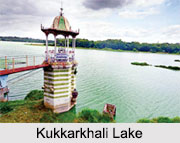 In the year 1864, under the patronage of Mummadi Krishnaraja Wodeyar of the Mysore Dynasty the lake of Kukkarakhali was created to provide irrigation to about 10,000 acres of land outside the city. The lake is spread over an area of 150 acres and has a shoreline of about 5 km. The Kukkarkhali Lake was used as a source of water supply to the city of Mysore but over the years, excessive land encroachments, sewage and blockage of water sources almost led to the eutrophication of the lake. The maximum depth of the lake is almost 16 feet.
In the year 1864, under the patronage of Mummadi Krishnaraja Wodeyar of the Mysore Dynasty the lake of Kukkarakhali was created to provide irrigation to about 10,000 acres of land outside the city. The lake is spread over an area of 150 acres and has a shoreline of about 5 km. The Kukkarkhali Lake was used as a source of water supply to the city of Mysore but over the years, excessive land encroachments, sewage and blockage of water sources almost led to the eutrophication of the lake. The maximum depth of the lake is almost 16 feet.
Hydrology of the Kukkarkhali Lake
The geological condition of the Kukkarkhali Lake mostly ranges from sandy loamy to clayey loam. The lake drains a catchment area of more than 414 sq. km. There was the Dewan Poornaiah feeder canal stretching for 27 km which passes through Hinkal, Bogadi, Kudremala and Manasagangotri outfalls into the lake. But this feeder canal has shrunk over time from 27 km to 5 km due to the effects of urbanisation. There is a bund on the east-west side which holds water on one side and on the northern side; another temporary bund holds back the direct flow of waste water into the lake.
Detailed research conducted between the periods of 1981 to 2001 confirmed the deteriorating status of the lake. There was a high percentage of bio-chemical products in the lake because of the death and decay of algal blooms adding to the bio-chemical concentration. The lake water showed high electrolytes, low dissolved oxygen, high phosphate and nitrogen content with abundance of plankton blooms, all of which have contributed to a high degree of eutrophication.
Restoration of the Kukkarkhali Lake
The deteriorating status of the lake necessitated action for restoration. In 2004, water-harvesting facilities were suggested at heritage mansions and buildings that dot the area around the lake. With the help of the state government along-with the support of the University the restoration and development of the lake is being made. The university has undertaken the task of clearing algae and weeds from the water surface. After trying many other methods, they have now employed a `sand sucking boat` technique to clear the dead plankton, weeds and decaying algae which have made the place stinky. The lake is under chemical treatment to remove the foul smell emanating from the decay collected on the water surface, especially on the lake bund facing Hunsur Road near Paduvarahalli. It was suggested to divert the sewage flow with the help of the Mysore City Corporation.
Other methods for the lake restoration included the widening of the bund on the southern side, fencing of the lake perimeter, ban on immersion of idols in the lake and the dumping of medical waste. There should be an increase in aquaculture and adopting aeration of water techniques, like boating.
Flora and Fauna of the Kukkarkhali Lake
The Kukkarkhali Lake is home to more than 180 species of birds, some of them aquatic. During the migratory season the lake plays host to a variety of exotic birds, some from as far as Siberia. The birds found in the lake are Spot-billed Pelicans, Little Cormorant, Painted Storks, Open-bill Storks, Eurasian Spoonbills, Black-crowned Night Herons and Oriental Darters. The Bird Life International has included Kukkarahalli Lake in the list of 38 Important Bird Areas in Karnataka.
Visiting Information on the Kukkarkhali Lake
The lake is located within the Mysore city limits. The Mysore City railway station is about 3 km from the lake. The Mysore airport also known as the Mandakalli airport is at a distance of 185 km from the lake.



















